Rima: So when I say six months of research, it means that this is the budget that was planned for that. But most of my work takes about… The longer pieces that I do, they take quite a lot of length of research, so we’re talking two to three years actually. So with Think Much. Cry Much., I wanted to work about border crossing or borders in general because during that period of time in 2015 and until this day when we talk about borders, we’re directly only speaking about refugees. And even though what’s at play is a much larger system obviously, it’s not only state system, but we’re talking about the media, we’re talking about the workers who actually come and put the fence, we’re talking about the technology part.
For example, especially at the EU, they develop this company called Frontex, and they were developing this weird kind of technology and robotics to go to the border and to stop the people from entering. So when I talk about research it meant—and the police of course, and the media—so during that research part, I met with a lot of asylum seekers and refugees, but also I tried to go and see to different countries. So, the funders or the festivals that produced that work, I told them that I want them to create residencies for me in each place. And because they were all in Europe and all had a say, if you want, or a quota for refugees. So in each place I went to meet refugees or asylum seekers, but also I was trying to meet with train drivers, with policemen, with people who put the fence on or the fence company.
Or for example, I was fascinated at that period with instructions, like how the system in a way create very minimal instructions. So for six months I’ve been like, wow, following arrows or at the airplane, I would take all of these safety instructions and trying to understand safety for who, safety for what, what is the safety. Like when they search you at the airport, the security measures, they always say, “It’s for your safety.” It’s like, I don’t understand why someone needs to touch me for my safety or why do I have to empty everything for my safety? Yeah, so this is what we’re talking about research. And again, it means during this research period, it’s kind of trying to be very attentive to the everyday. So when I’m going as well to visit the borders, it doesn’t mean that my work starts at the border. No, it means that all the way on the train, I’m trying to be attentive. Sometimes I’m just filming nature or just looking at people. But also, it means that it’s kind of going all the way with the everyday of what happens and talking to people. And then from all of that, how do we create a script for a performance?
Nabra: And so what did that performance look like, to give our listeners an idea?
Rima: So, it looked different each time, very different, because it depended on the audience. When you arrive to the performance, you receive headphones and you receive instructions through the headphones. Yeah…the whole performance was written in a way that there are eight channels. So by the end of it, or if you are sitting outside or standing outside, you would look at a choreography if you want. It’s very simplistic one, so each channel is different than the other, but everyone goes through all the channels. And obviously everyone figures out after the second time, you start to realize that these people are doing what I was doing.
At one moment, the performance, with the transition of each channel, there is a common choreography that everyone has to do it. And this is the only time where you hear not a refugee story, but you hear the conditions of what does it mean to be a refugee. And one time you hear about the kind of food or the structure of where they’re staying. So I kind of tried to avoid as much as I could as well to be trying to represent refugees in this performance or border stories, because I feel like there was a lot of that.
And in many ways, in most of my work, not only in this work, I kind of don’t feel at ease to represent many things, but to reproduce and find frictions. So it’s not surprising for me most of the time that people are not very satisfied. They say, “What was that?” And for me, this is like, okay, I can work with that much better than just to do this representation in general.
People are like, “Palestinians are humans too, and if you watch these stories on Instagram, your view will be changed,” and it’s still going into month eight of a genocide. So clearly that narrative is not working.
Marina: And in one of the articles about this piece, someone wrote that you hand a slip of paper to people after that says, “This performance piece will not change your life,” and I was wondering if you could talk more about that.
Rima: Especially with the war now, but let’s focus on the refugee crisis. What happened, especially with the media, I met with journalists during the research, and I tried to understand from them how they cover the stories and why certain borders, why certain stories, why all of that. Most of it’s to try and make other people feel how horrible it is and how should be very humanistic with each other. And obviously I don’t believe in this kind of solidarity, like this humanitarian solidarity, because I don’t think it’s real in many ways. So I needed to be very clear that it’s like, don’t resume your guilt. If you come to attend the story about refugees, about borders, then you will understand what’s happening. You will never understand what’s happening because obviously you haven’t been into that experience. It’s just trying to make it closer to everyone to understand that the system that we all live in works with different people and different privileges in different proximities maybe. In this way, I didn’t want for audience to say, “Oh, I’ve been into this refugee performance.” It’s like, this is wrong. As a sentence, it’s wrong for me. So yeah, I don’t know if that answers your question.
It’s not only the audience at play, but myself as an Arab woman, so myself representing myself as the performance artist, so the object of the piece.
Marina: It does, and it touches on something Nabra and I talk about all the time, which is we can’t stand the humanizing narrative. And right now what’s happening with the current genocide, I think proves that that’s true is people are like, “Palestinians are humans too, and if you watch these stories on Instagram, your view will be changed,” and it’s still going into month eight of a genocide. So clearly that narrative is not working.
Rima: Exactly, exactly.
Nabra: It’s also ridiculous to have the point be “blank are humans too.” We talk about that a lot with especially earlier waves of art, trying to just get to the basic, which isn’t even the basic, it’s before the basic. And so how can we have a more nuanced conversation if we’re not even at that level with each other? Yeah, that’s something we’ve talked a lot about and a lot of artists have brought up, especially MENA and SWANA artists.
Rima: Yeah, yeah, totally.
Nabra: Another piece we wanted to talk about is Dress Me How You Like, which is how I first learned about you and got very excited about this piece. I think it’s brilliant as a feminist and culturally informed performance art piece. So can you talk about that and where that idea came from and also maybe where it’s been performed, because from what I understand, it’s a piece that’s gone around, and you are the center of that piece, so I know it’s very mobile. So, a little bit about its history as well.
Rima: It’s not very mobile to be very honest. I think it was performed only twice in two different venues or three different venues, one of them is my home, and that was I think my second piece that I’ve ever done.
Where did the idea came from? I don’t honestly remember very well, but I think it was very much related to moving from New York to Berlin, and being in a drumming class, and having to hear what an Arab woman should be. I’m fascinated still with always—also this may be responds to your very first question, “What are you working on next?”—with Egyptian pop cinema and the personas that are created from there, I find it’s like a gold mine I keep going back to. The piece, if you want, it happened quite quickly, and it developed. So first it was in 2012 that I submitted this, and I was much younger obviously, so I was eager to just do and submit and try things and all of that. And so this is how it started.
I started, learned how to sew through YouTube and was watching a lot of videos and talking a lot about this idea like Western Hollywood movies, how they’re portraying Arab women, so how a Western body if you want wearing Arabness, and what does that mean. It’s very obvious concluded you need to be a harem or a belly dancer that is oppressed by men and society or a terrorist. And as a terrorist, you don’t belly dance, but mostly you do belly dance as an Arab woman.
And I had a lot of fun with that. So I invite people to attend, and the group of people should be maximum eight, and each group will choose some garments, dress me, then make me pose, and then they take a photo for me, and then they would pose, they can dress up as well and come and stand and take a photo so we’re all inside the photo. And then what happens is that because the garments, they’re all inspired by Hollywood movies, so obviously they’re all orientalist. And my whole idea is it’s kind of like how the Hollywood movies corners us and how the perception of… Because before actually, I’ve never realized that the perception of Arabness is that kind of informed only by Hollywood movies or stereotypes that much, naive of me. But yeah.
Nabra: You’re saying that afterward, after they dress you, I think you were going to talk about what happens after that.
Rima: Right. It’s kind of cornering them, so it’s kind of talking back at any audience member who dares to come to such a performance, no? Even that you don’t say or you don’t think of that, but it’s kind of, okay, let’s play. But in that play, there’s obviously, there’s very clear position that we’re taking. You’re going to be dressing me, again, in orientalist garments that look very tacky. And I love it because I did them, but yeah. But yeah.
And then I developed a lecture performance out of it as well, which is a lot of fun as well, because… So I was kind of commenting on what had happened in the performance by creating another layer of talking back, if you want, to the audience, but as well by simply analyzing the references that got me to this piece. And as well, trying to understand these different positions of, it’s not only the audience at play, but myself as an Arab woman, so myself representing myself as the performance artist, so the object of the piece. So what happens within the object when someone is touching you weirdly inside the performance? When an Arab audience comes in as an…? Okay, so all of these kind of encounters as well, what do they do, what do they produce, in terms of an understanding, in terms of an encounter, just simply by talking or describing these encounters?
And then I was invited again to perform it I think 2019 in Prague. So we’re talking eight years apart, and obviously I had grown in eight years, and I moved quite a lot of houses as well, so most of my things were gone to the streets. So I worked with a theatre, National Theatre of Prague, and I went to their own theatre archive to fetch more costumes. Then it was a lot of more fun as well, the piece, because then we had different setups. I worked with Maria Kassab, she’s a—we collaborated quite often—photographer and visual artist.
Yeah. So we created different kind of studio setups, and I had more budget, so I created more costumes as well. And that space was very big, so we could really play quite a lot. And I changed the interaction a bit. So I had theatre staff to sit with me in my tent, so when they arrive, people arrive, there’s already people just dressed up and sitting, watching. And the costumes were more informed or more detailed in many ways, and the photos as well, they produced a better reproduction, kind of collage of different aesthetics, material, meanings. Yeah. It was a bit more informed,
I think as well it’s much more related as well to my confidence in relation to the audience. So after one have practiced a bit. Because as well, there is always the question, how do you rehearse such a performance? There’s no way of rehearsing. You can imagine as much as you can, you can create your exit and entry strategies, you can do all of that. But there is something as well about myself as a performer and how confident I became, played a big role in my comfort in receiving the audience and all of that.
Marina: Yeah, that makes sense. And I mean, what you were just talking about, I love, so from 2012 to ‘19, you’re talking about this shift in confidence. But I’m just curious, how has your work evolved over the years? I think the confidence, I’m sure, is one thing, but from how you started, which maybe you can tell us a little bit about how you started doing this work, to where you are now, what do you think are the big evolutions in the work that you make?
Rima: Well, evolutions, how to talk about that? I think because it’s just like to learn how to work with other people, this is the biggest evolution that could happen, and still I’m always learning. I’ve been very lucky to collaborate with brilliant people and artists.
Marina: Can you talk a little bit more about just how you started doing performance artwork? Did it evolve from a theatre practice? I think that’s how often people get started. But yeah, I’m just curious. We read your artistic bio earlier, which was beautiful, but it didn’t have some of those origin points, so would love to hear about that now.
Rima: So I studied theatre at the Lebanese University in Lebanon, which I’m very proud, of course, because it’s a public university and I think it’s one of the best universities for theatre when I was still studying there, for theatre in Lebanon. But when I was studying, I was working at ten different jobs, which I continued to do after I graduated. So I was translating, I was a dancer, I was a stylist, and an art director, so set decorator that means in the language we’re using now, I was working at coffee shop, I was assisting a photographer, I was producing, I was visual editing for a Lebanese TV channel, so many, many things.
And so that meant it’s not only theatre in a way that informed what I do now, but these many other elements as well. So to be on a music video pop song or to produce an advertisement and the amount of work that it is happening for thirty seconds, someone just drinking soda or whatever, It didn’t matter really what the project is, it’s just like, “Okay, let’s work. Let’s do things. Let’s make money because we need to live,” et cetera. And studying theatre in Lebanon as well, it meant that for most of everyone it’s like, what are you really doing, really, really? Because you really need to be stubborn and you need to do many other things in order to be an artist in Lebanon unless you got it, somehow you have the gate open to you.
So yeah, this is my background. And then at one point I was kind of done, not from Lebanon, but I went into a place growing up in Lebanon and spending maybe eight years in Beirut. It’s like, okay, Beirut is a very tiny place and I feel like I need to develop. And so I went to New York at the time, and I applied and did a Master’s degree at NYU Tisch Performance Studies. And I was in a conflict with myself because I come from this practical background, and it’s a theoretical program, and I didn’t understand what does that mean. And then I understood.
And also it meant that it’s not the only thing that I didn’t understand in the beginning as well. I want to mention this because I’ve been thinking a lot about it lately. It was the first time that I see a Lonely Planet guide for Israel, so that meant Israel is real, because up until that point, I was still like… It’s like I meet with Israelis and everything, and it’s like “no.” And that kind of two big realization in many ways that were happening at that period of time, and it made a lot of conflict in me because I know how to do things, I don’t know how to write a paper. So I had to learn, and I resisted a lot, but I had to learn the tough way and I learned a lot, such an interesting program and in many ways and it teaches you criticality. But it took me years to figure that out actually. When I was there, I didn’t figure it out.
And while I was there and because of the need that… I need to produce, I can’t be just sitting reading and writing papers. It happened that I met, or I was living in a loft for a Lebanese dancer choreographer, and I think now he’s a gardener, Makram Hamdan. So I had this big loft in Bushwick, and this is Bushwick before now it’s very yuppie, or so I discovered. I don’t know, so someone told me. And he had the idea of we have a big space and everything, let’s try to make a residency. So we make monthly, or no, it was Bushwick Open Studios actually, and he asked me, do you want to participate? And we can do something, we open the loft and make studios.
And this is how I decided that it’s like, okay, let’s do smaller pieces, there’s no theatre. This I was used to already from Lebanon because at the Lebanese university, conditions are very, very basic. People are creating the conditions all the time for themselves to be able to do the theatre. So it was kind of, okay, let’s try things out. The first piece I did ever, it was called Passage. So where people come in blindfolded and there’s the different textures, there’s live music in this very small room, and I’m guiding them through the different textures inside the room.
Nabra: I really appreciated how much video there is of your work available. And I don’t see that a lot, especially from theatre artists or people who do any type of live performance really. It can be difficult to do that, but a lot of the video itself is a piece of art. They’re not just the documentation from the back of the house where you see the blurry people on stage or something like that. But really the video documentation is a piece of art unto itself. So I wanted to ask you about that and how video plays a role in your work and whether you always have a video component, a live component, and photos when presenting a piece, or how you think about that multidisciplinary way of presenting your ideas.
Rima: So most of the time, video… As well, before we say that, I want to say thank you to my now I think friend and collaborator, Ana Nieves, aka La Manchega, because we’ve been working quite a lot and she’s my video person and friend I’m always working with. Even though we don’t live in the same city anymore, but we understand each other in many ways. And so even if I’m making the video, but it’s kind of like video and photos are a product, right? I’m always thinking about them as a product. And a lot of my way of looking at things, when I talk about reproduction or production, I mean it’s like, okay, so these kind of aesthetic, even though they’re not intended, once they are in video or photo, they are product by themselves, and what do they create then?
This is why most of my work is informed by videos, photos, and I kind of, in many ways, I let them create the aesthetics. So I’m more oriented towards a feeling or like, okay, it’s like how do we make a photo that generates a product that can talk about what I’m trying to do, even though a lot of times it doesn’t happen. You end up with a video, video that doesn’t have a good sound, so how do we then work with this video to do what it needs to do without the sound? What are the alternatives? But video and photo in general, videos, they’re a great source of inspiration as well for my personal self. So this is why I find it a fascinating medium, even though I’m never a professional doing that. But I do as well my own video works that are very amateurish if you want.
I’m not thinking that this should be a feminist performance or this should be a political performance or any of that. Just because I am feminist and political and so on, then obviously the work is.
Marina: Well, I hear everything you’re saying, and I agree that you can’t capture everything in the video for sure, but I did feel very inspired watching the videos of your pieces. I also did want to participate in different ways. And so that’s where I felt like, “Oh, okay, well, the video will never give me the chance to do that, but it did give me a taste.” So I was really grateful for this archive that you’ve created of the work, especially because as Nabra and I have talked about, and we were talking earlier with you about, it is important to really have an archive of our MENA and SWANA art that’s being made. Because when I think of performance art, I always think of Marina Abramovic first, which is fine, great performance artist, but why are our references this one person as opposed to really having a more capacious understanding of the different performance artists and the different concerns that are coming up with performance artists?
Rima: Well, I appreciate you saying that, and I’m happy that… because sometimes I realize, maybe we didn’t do enough or maybe it wasn’t good. So it’s good to hear that this is how it is perceived. Yeah, cool.
Marina: Is there a certain, excuse me, message or theme or idea that connects to your pieces? Nabra and I were talking about them, and we were like, oh, these feel very feminist, but the word “feminist” can be loaded in different ways, and so I don’t know if that’s how you identify them. But we would love to hear you discuss, is there something that sort of connects them all together?
Rima: Okay, so this question stays with me because a lot of times when you do something you don’t understand, or when I do something, I don’t understand what I’m doing, or I think that I understand, and then years later it’s like, oh, yeah, then it makes sense, but that can change as well. It’s never really something that is fluid and brilliant, and yeah, I like everything. It doesn’t happen that way. A lot of times, I wished that I interacted differently or I did something different. But luckily I am a performance artist, so I can always go back and do whatever I want with it, right?
And so what links everything together I think is the… Or what I think that I arrived, this is my last conclusion, it’s like how emotions have their physicality and how they interact, but it’s not only emotions, it’s as well stereotypes and emotions and violence. Because now I’m just trying to track the different pieces, and with each piece… okay, I talk about violence in some of them. I talk about borders. I talk about gender, I talk about my last piece, revolution and birth, and I’m very interested in what does that do to the body? And how do we articulate that? How does it choreograph the body? How do we sometimes really embody this, let’s say? How do we embody the violence, and how does that make us not feel, but express ourselves? And how can we then switch these moments by only expressing them? How do we create a rupture in this general narrative by just putting it out loud?
I’m not thinking about what links them as feminist, because it’s inherently, I’m a feminist, and feminism is obviously very wide and in schools and spectrums, so it’s kind of like saying, talking about psychology. And I don’t agree with all of the schools, and I don’t have to, but it’s just in that way, I’m not thinking that this should be a feminist performance or this should be a political performance or any of that. Just because I am feminist and political and so on, then obviously the work is.
Marina: So we were chuckling because Rima has two children. We just heard one of them, although the background for me we’re hearing construction, so I think I would much rather hear the sounds of children, it’s much more joyful.
But Rima, loved so many of the things you just said, including yeah, the work is feminist because I’m feminist. And so it’s your feminist school of thought, not just whatever feminist school of thought.
But also you talked about rupturing a narrative or narratives, and that I feel has been a theme for the things you’ve described. Like, oh, you think you understand borders? Actually, let’s interrogate what you understand about borders, what we understand about them. Oh, you think that you understand Hollywood? Let’s see what happens when you are the Hollywood producer who’s getting to design the costumes and getting to be the photographer here, or the person who’s posing you I guess. And even you were just talking about motherhood, and what is birth, what does this do, and reinterrogating this narrative that I think there’s a common narrative of yes, and mothers give birth and then they have children, and yeah, what does that mean? So I really appreciate the way that you’ve talked about rupturing these narratives, because I do think that when I think of your art as thought provoking, I’m like, that’s what those thoughts are provoking is actually what do I know about these things and how have I come to any of these conclusions at all?
Rima: That’s great to hear. And then as well, I want to add a little because it’s like this total conception, because when we’re speaking about revolution and birth, it’s like, oh, birthing a revolution, oh, revolution and the birth of… It’s like, no, no, no, no, no, it’s something very personal actually. It’s something that you have to do with your body. It’s not something that you have to perceive, or as well with borders and refugees. So yeah, totally, it’s kind of like, again, we have to do these things with our bodies. It’s not something that you are only perceiving. When you talk about, for example, revolution, everyone has a certain image, no? Or you talk about the war, it’s always this kind of stereotype of an image, or Hollywood, or Arab women, or suicide bombers. Yeah. There’s always this kind of complete total perception. And yeah, I’m interested kind of at tweaking or rupturing or taking the piss really sometimes.
Nabra: I love that.
Rima: My bio, yeah, exactly.
Nabra: I love that we’re ending with taking the piss because it’s perfect. Thank you so much for joining us and for talking about all of your work. I really encourage everyone who’s listening to check out Rima’s website and actually look at the images and videos that have come out of that work, because you really can’t capture everything just from describing it or even from seeing what’s archived, so hopefully one day we’ll be able to experience your work live. Thank you so much for being here.
Rima: Thank you for having me, and I’m very emotional when you say these words.
Marina: Thank you so much, Rima.
This podcast is produced as a contribution to HowlRound Theatre Commons. You can find more episodes of Kunafa and Shay and other HowlRound podcasts by searching “HowlRound” wherever you find podcasts. If you loved this podcast, please post a rating and write a review on your platform of choice. This helps other people find us. You can also find a transcript for this episode along with a lot of other progressive and disruptive content on the howlround.com website. Have an idea for an exciting podcast, essay, or TV event the theatre community needs to hear? Visit howlround.com and contribute your ideas to the commons. Yalla, bye!
Nabra: Yalla, bye!

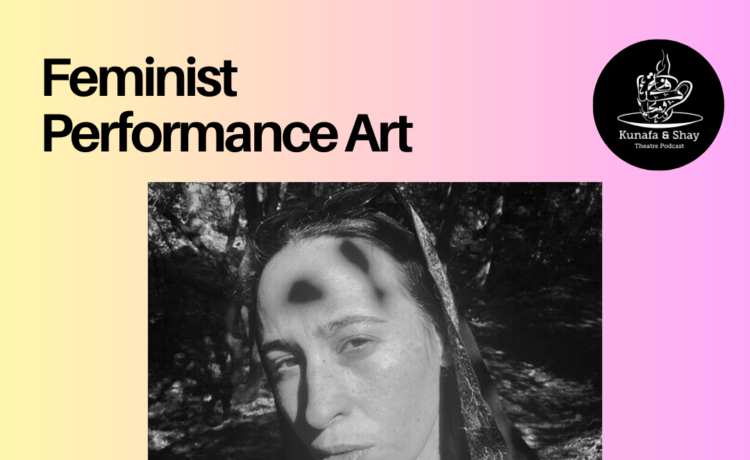
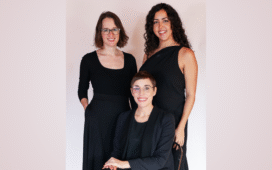
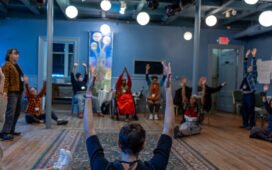
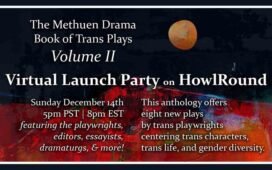
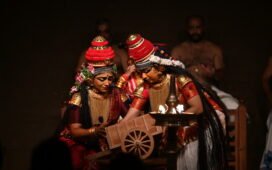
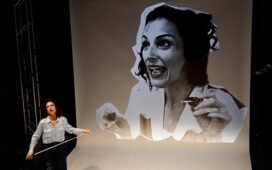

Recent Comments